Exploring evolutionary mechanisms of genomic divergence in marine intertidal limpets
IF 3.9
2区 生物学
Q2 ECOLOGY
引用次数: 0
Abstract
Decades of research in population genetics have revealed that genetic divergence between populations and species is not uniformly distributed throughout the genome but rather exhibits a high degree of heterogeneity. Two main conceptual models—allopatric divergence and divergence with gene flow—have been proposed to explain this variability under natural selection. Here, we investigate patterns of genomic divergence in three marine limpet species, Scurria scurra, Scurria araucana, and Scurria ceciliana, across two major biogeographic breaks (30–34°S and 41–43°S). Genomic divergence varied among species, even between the two sympatric species S. scurra and S. araucana, which exhibited heterogeneous divergence patterns across the 30–34°S range. In S. ceciliana, the southernmost species (41–43°S), divergence was shaped by a combination of allopatric divergence and divergence with gene flow. This was unexpected given that its evolutionary history suggests past isolation in glacial refugia, which would have limited gene flow. However, the observed genomic divergence indicates that genetic exchange occurred between populations, challenging previous assumptions about its evolutionary dynamics. Divergence patterns appear species-specific, with few shared genomic regions, though more similarities were found among the sister species S. scurra and S. araucana. In highly divergent regions, genes associated with lipid metabolism were identified in S. scurra and S. araucana, whereas genes related to oxidative stress response and mitochondrial functions were found in S. ceciliana. These findings suggest that genomic divergence is not entirely stochastic but may be shaped by different selective pressures in each species, potentially reflecting adaptation to distinct ecological conditions.

探讨海洋潮间带帽贝基因组分化的进化机制。
几十年的种群遗传学研究表明,种群和物种之间的遗传差异并不是均匀分布在整个基因组中,而是表现出高度的异质性。两个主要的概念模型-异域分化和基因流分化-被提出来解释自然选择下的这种变异性。在此,我们研究了三种海洋帽贝,即Scurria scurra, araucana和ceciliana,跨越两个主要的生物地理断裂(30-34°S和41-43°S)的基因组分化模式。同源种S. scurra和S. araucana在30-34°S范围内表现出异质性差异。在最南端的物种(41 ~ 43°S), S. ceciliana的分化是由异源分化和基因流分化共同形成的。这是出乎意料的,因为它的进化史表明它过去在冰川避难所的隔离,这将限制基因流动。然而,观察到的基因组差异表明种群之间发生了遗传交换,挑战了先前关于其进化动力学的假设。尽管在姐妹物种S. scurra和S. araucana中发现了更多的相似性,但分化模式似乎是物种特异性的,几乎没有共享的基因组区域。在高度分化的区域,在S. scurra和S. araucana中发现了与脂质代谢相关的基因,而在S. ceciliana中发现了与氧化应激反应和线粒体功能相关的基因。这些发现表明,基因组分化并不完全是随机的,而可能是由每个物种的不同选择压力形成的,潜在地反映了对不同生态条件的适应。
本文章由计算机程序翻译,如有差异,请以英文原文为准。
求助全文
约1分钟内获得全文
求助全文
来源期刊

Heredity
生物-进化生物学
CiteScore
7.50
自引率
2.60%
发文量
84
审稿时长
4-8 weeks
期刊介绍:
Heredity is the official journal of the Genetics Society. It covers a broad range of topics within the field of genetics and therefore papers must address conceptual or applied issues of interest to the journal''s wide readership
 求助内容:
求助内容: 应助结果提醒方式:
应助结果提醒方式:


